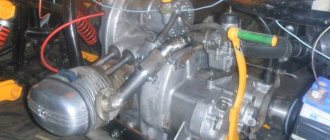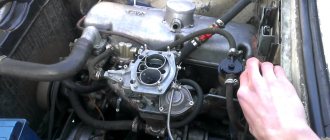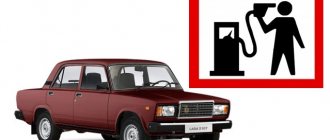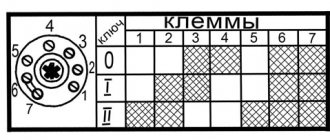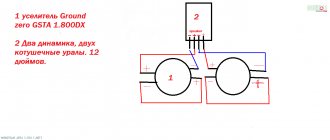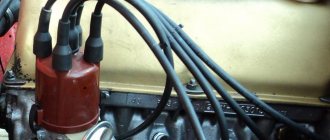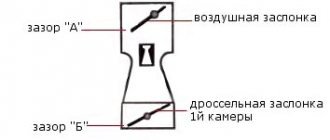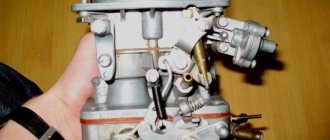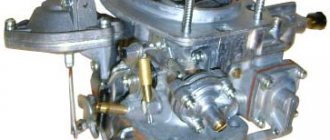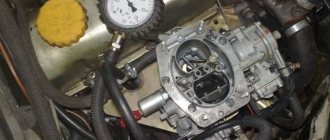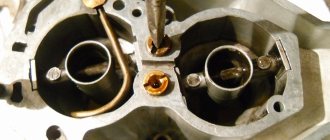Is it possible to install one carburetor on a Ural motorcycle? This question is asked by many owners of popular motorcycles in our country. The reason for this interest is obvious. Ural motorcycles, regardless of the year of manufacture, are standardly equipped with one carburetor for each cylinder. This provides better filling with the combustible mixture, but creates many problems during adjustment.
After all, synchronizing the operation of the cylinders is not an easy task even for an experienced specialist!
Everyone who has at least once adjusted the supply of a fuel mixture in the Urals knows this. Neither the latest domestic model K-68, nor the Japanese analogues from Mikuni are able to solve this problem. Moreover, the general condition of the engine also has an impact.
A little about carburetors for boxer engines and their alternatives
Since the time of Tsar Goroksa, domestic boxer cars have been equipped with carburetors made in the city on the Neva. All that could change was the location of the float chamber, the diameters of the jets and the shape of the throttle valve. Just as everything changes in the process of evolution, consumers received the latest device for preparing the fuel mixture - K-68. Although it is already morally outdated in our time. But this does not change the topic of conversation.
It is clear that it is better than its predecessors, but by how much? That is the question! I also have K-63 on my K-750 and they perform well! In general, K-65 carburetors are praised, even those of Chinese origin. I personally bought it for the boys in Kharkov, and they performed great! I don’t know what kind of new Urals they are putting in now in Irbit. We don’t put anything on the Dnieper at all, because they don’t produce them anymore))))))))
But this is all reasoning during which the question arises: which carburetor is best suited for a four-stroke engine? So let's try to figure it out a little.
First, let's find out what types of carburetors are installed on motorcycle engines and why. They are distinguished by the way the throttle valve moves. Hence, all modern carburetors (of mass use, of course) are divided into two types: direct drive and vacuum.
- Variable resolution carburetor: 1 - throttle valve; 2 — throttle cable.
- Constant vacuum carburetor: 1 - throttle valve: 2 - air damper; 3 - piston; 4 - return spring; 5 - vacuum channel.
In the technical literature they are called differently - with variable vacuum in the carburetor diffuser and with constant vacuum (previously they were called SU), respectively. K-62-68 is a representative of the tribe of carburetors with variable vacuum. They have a throttle valve with a metering needle attached to it. A cable from the throttle handle is attached to the damper. It's simple; If you want to go faster, turn the throttle towards you, pull the cable, it raises the throttle valve in the carburetor diffuser. The throttle, rising, frees up the passage of more air into the cylinder. A larger amount of air, mixing with fuel in the diffuser, creates a larger amount of fuel-air mixture. As the engine speed increases, your device accelerates. Everything is extremely simple. But in this simplicity lies the reason for failures that cannot be eliminated in principle. Air passing through the tapering section of the diffuser, in full accordance with Bernoulli's law, has a pressure below atmospheric pressure - a rarefaction occurs. It is the vacuum that causes the fuel to rise from the float chamber up to the diffuser and mix with air. Roughly speaking, the air in the diffuser sucks fuel out of the carburetor. The presence of vacuum and its magnitude (at least 9 mm Hg) is a necessary condition for the carburetor to work.
Let's go back to failure. You quickly open the gas, and the diffuser cross-section also quickly increases. But the engine speed cannot increase instantly and at the first moment remains unchanged. The flow area of the diffuser has increased, but the air flow has not yet changed, therefore, in accordance with the aforementioned Bernoulli law, the vacuum has decreased and fuel has stopped being sucked out of the carburetor - which is why a classic failure occurs. To avoid it, you must either open the gas slowly, and then the engine has time to “spin up” following the movement of the throttle, or abandon the carburetor with variable vacuum. Nowadays, the Ural is perhaps the only motorcycle in the world with a large-volume four-stroke engine, equipped with variable-pressure carburetors. But again, this applies to motorcycles that are a little older. Previously, motorcycles kept him company, but today even the Americans have moved away from the archaic design. All other companies install carburetors with constant vacuum on their four-stroke motorcycle engines. (see photo below - one of the options)
Keihin CVK30 CV carburetors for Kawasaki Ninja 250R. Constant vacuum carburetor
As one of the options for robots of this type of carburetors
What is their fundamental difference? Here two elephants stand one after the other: air and throttle. The throttle valve is located in the same place as in the carburetor with variable vacuum. The air, driven by a throttle cable, is placed in front of the throttle - closer to the intake valve. The throttle valve with the metering needle is moved in the well by a special piston. The piston is designed as follows: a very soft spring placed in the space above the piston tends to move the piston along with the throttle valve towards the closing direction. The vacuum in the diffuser created between the throttle and air valves is supplied through a special channel to the space above the piston and tends to raise the piston and throttle valve when the engine is running.
How does it all work? Suppose you are driving in third gear at a constant speed of 20 km/h and then suddenly give full throttle. With carburetors of the K-62 type, for the reasons described above, a deep failure occurs in the operation of the engine. To avoid this, suppose you installed Mikuni carburetors (see photo). Pretty good carbs!
When you open the gas, you open the choke and... one might say that they informed the carburetor of their intention to accelerate - nothing more. Since the speed was low before the gas opened, the air flow through the diffuser is also small, which creates a small vacuum in the diffuser. The force created by this vacuum and forcing the piston to open the throttle valve cannot overcome the action of the spring, and the throttle remains closed. As the engine speeds up, the vacuum increases and the throttle valve opens further and further. By opening the gas to full speed at low speed, you perform an incorrect action in relation to the carburetor, and it itself, with the help of the pneumatic throttle valve, corrects this error. The throttle valve is always automatically opened as much as required for best acceleration. It is this property that allows you to enjoy the process of movement without constantly thinking about how much gas you can “open”. It’s a pity, but the guys in the opposition can only dream about it.
The whole advantage of the K-68 over the old K-62 lies in the cylindrical throttle - it allows you to maintain stable idle characteristics. The K-62 type carburetor, when repeatedly opened and closed with the throttle handle, provided the engine with arbitrary idle speed. And with the next release of gas, the engine continued to operate at increased speeds - that’s why you have to use the quantity control screw to reduce the speed. But the next time you open and close the throttle, the engine spontaneously stalls. And so on ad infinitum. Since a true biker strives to fly past even a red traffic light, the operation of the carburetor at idle, whether good or not, is not very important to him. Another thing is drive. And here carburetors of the K-62-68 type are powerless: the rapid “opening” of gas does not lead to acceleration of the motorcycle, but to the loss of all power. And in order to continue moving, you will have to close the throttle and repeat the movement with your hand, but more slowly. Motor power works like a voucher - it is available, but cannot be used.
The only justification for the K-62-68 is that there is always a failure when accelerating a motorcycle with a four-stroke engine if a carburetor with variable vacuum is used. Regardless of where it is made - in Russia or Japan. But there is a good cure for such “sores”: the same ones mentioned above, any Japanese “Mikuni” or “Keihin” of constant vacuum, will be suitable for the “Ural” and “Dnepr”. Their distinctive feature is the characteristic cylindrical canister above the throttle valve - this is the throttle pneumatic drive. As a rule, Japanese motorcycles have one carburetor for each cylinder. Since the power of each cylinder of a 400 cm/cc engine (the most common second-hand capacity) is approximately equal to the power of a Ural or Dnepr cylinder, the carburetors of motorcycles of the 400 cm/cc class are suitable for the bore section. But to install them on the Ural, you need to prepare. First you need to make adapters to secure the carburetors to the heads. Attention, carburetors are mounted only on elastic suspension! Next, the air damper drive also needs to be slightly modified - in accordance with the design of the drive in the Ural. The second stage is setting up carburetors for use in the Urals. It is absolutely necessary, because a K-62 carburetor with all fuel-metering elements (and there are already twelve of them on the K-62!) is tuned to the Ural engine and can work better than any “Japanese” that is not tuned to this engine.
Fairytale world | Topic author: Motorcycle
Hi all! ) guys, please tell me how best to make one carburetor in the Urals? While the motorcycle is being repaired)
Zhenya (Aheahe) I ALSO HAVE THE SAME MANIFOLD WELDED AND THE CARB WITH A ROUND VALVE. PREVIOUSLY FROM 6 VOLTS JAV COSTED IT HANA CAME STOPPED INSIDE AND GAS. GASKETS FROM PETROL RESISTANT RUBBER TO THE CYLINDERS FROM FIRE EQUIPMENT BOY BROUGHT FROM WORK. ONLY WITH A DURAL TRANSMISSION IT IS SAD TO SAW WHEN REPLACING.
SEREGA (Crista) don’t be foolish, put it as is, 2 carbs
Alexey (Fawz) My dad took arches from a spring bed (the ones made of stainless steel), welded large washers onto the ends to create a flange. Next, the pipes were welded together at the place where the air intake was attached (the place was ground off), and a regular carb was installed, only with a wider main jet. I apologize if I explained it crookedly
Alexey (Fawz) although they advise installing a carb from Oka, but honestly, I don’t know
Max (Mahabahu) I RECOMMEND 2 CARB
Gennady (Lora) Even in the fall, in damp weather, the carburetor will freeze. do immediate heating from the exhaust pipe. Or a 12 volt electric heater.
Kirill (Reanne) joins the last posts, I also made one carburetor (Ural) also from bed showers, I didn’t notice much savings, but the draft dropped and the carburetor even in the summer if you let coke on the highway become covered with frost, not to mention if the weather is cool with There are a lot of problems when starting the engine, so I ended up redoing everything as it was originally.
ivan (Quantay) install the original ones, just adjust them well and everything will be top-notch
Dimon (Jewell) It's worth the carb from the Oka (DAAZ 1111) in the fall we drove at (0) it just started to sweat. I was covered in ice at (-5), but I was driving.
Dimon (Jewell) Then they turned on the heating from the exhaust. RESULT: starting the engine in winter at - 20 from the 2nd time, while it warms up it works unsteadily, after warming up it purrs like a kitten.
Dimon (Jewell) Consumption was measured (6, 2) liters. And this despite the fact that the quad weighs 427 kg. Permanent all-wheel drive on all 4 wheels, high-speed gearboxes from the VAZ 2107. I think that the Ural in its standard configuration would fit within 4 liters.
Dimon (Jewell) And lastly, in the summer we raced with Dnepr 11. At 1 km. lagged behind him by a body. Here is the experience of installing a carb from OKI. I won’t be back for the 2nd for sure.
Gennady (Lora) I also stirred things up. the result is not so impressive. Maybe on a quad the engine is covered and not so exposed to the wind.
Max (Mahabahu) consumption with 2 carbs in the Urals with a bridge of 10 on a single with a passenger and a lot of luggage 4 and a half liters at 110 km h tested at a mileage of 2500 km
Dimon (Jewell) Quite possible. After all, on a 10, the motor does the same work as on an 8, and the motorcycle covers a longer distance. But such a lineup is not suitable for everyone, but in general, what and how to bother with is everyone’s personal business and this must be respected.
Dimon (Jewell) If you're talking about freezing, that's not the point. In general, if you install a monocarb, then only a car or motorcycle with an accelerator pump, or a motorcycle with a constant vacuum.
Dimon (Jewell) However, the latter are incredibly expensive, and our second-hand OKOVSKY is very good. good condition 1000 rub.
Gennady (Lora) I installed it from 2108. Heating is needed. There is a box from the Dnepr, I had to file it a little, the air vent is attached, the filter itself is located at the right cylinder, sucks in warm air. Heating is done with oil through a copper tube around the carburetor. But the heating is weak.
Installing one carburetor on a Ural motorcycle
Is it possible to install one carburetor on a Ural motorcycle? This question is asked by many owners of popular motorcycles in our country. The reason for this interest is obvious. Ural motorcycles, regardless of the year of manufacture, are standardly equipped with one carburetor for each cylinder. This provides better filling with the combustible mixture, but creates many problems during adjustment.
What needs to be done to install a monocarburetor
If you install one carburetor on a Ural motorcycle, this will largely solve this problem. This is a possible, although not ideal, solution. In bringing the plan to life, certain difficulties will have to be overcome. Necessary:
- Clear space above the engine crankcase. This is where it is most convenient to secure the intake tract and connecting flange.
- Make an intake manifold.
- Select a suitable carburetor according to the parameters.
All this will require a significant investment of time and money.
Inappropriate installation option
What carburetors are suitable and what is better to install? We will have to disappoint those who plan to use available models from Oka or Zhiguli during the conversion. All car modifications are out of play in this case. There are several reasons:
- The vacuum in the intake tract of a motorcycle differs from the parameters typical for car engines. Because of this, correct adjustment of the carburetor on a motorcycle becomes almost impossible.
- The selection is carried out not simply by working volume, but by the number of aspirations per unit of time. Aspiration can be roughly calculated by multiplying the engine displacement by the maximum speed.
- Car models pose a danger if the motorcycle falls because fuel can splash out and ignite.
Automobile carburetors are not suitable for conversion!
So the idea of using parts from Oka or other automotive equipment will have to be abandoned.
Tricycle from the Urals and VAZ-2101
When creating a cargo tricycle with your own hands from the Urals and parts of a VAZ-2101 car, the easiest thing will be to install a regular bridge and make a car suspension with shock absorbers from the Urals.
The bridge from the VAZ-2101 is turned over, after welding the differential. This is reflected in the handling - the steering wheel is quite difficult to turn, however, the trike's cross-country ability increases.
The driveshaft is shortened and welded to the fork on the final drive and connected to the axle through a rubber coupling. It is better to take the original Uralov clutch, in this case the transmission will be softer.
To avoid bending the cardan drive, you can move the engine to the left by 7-9 cm, or move the axle to the right or increase the wheelbase.
It is better to leave the engine as a whole unchanged, but instead of two carburetors, make one Chinese one. And for forced cooling, use an air filter from Izh.
Additionally, to cool the engine when operating in difficult conditions, you can install two fans and run them separately if necessary.
Pros and cons of the design
+ Simple and cheap transport;
+ The engine does not overheat.
- Can only go forward;
— Too much load on the axle with the front wheel;
— Goes too fast in first gear.
The agony of choice
There is more than enough advice on the Internet about which carburetor to install for a Ural motorcycle. But not all of them should be trusted unreservedly. Indeed, in the process of realizing your plans, you will encounter considerable difficulties. Here are some examples:
- An affordable option can be considered the domestic K28G carburetor, which was equipped with the Tula-200 scooter produced during Soviet times. But there are no new ones on sale, and finding a used one in decent condition is very difficult. Unidentified defects will negate all expected benefits.
- Mikuni or Keihin models, borrowed from Japanese motorcycle models with a similar number of aspirations, cost a lot of money and will still require additional modifications. You will have to grind out new jets and change the factory settings.
Simply installing one carburetor instead of two without modification will not work!
Whatever option you prefer, simply installing one carburetor instead of two will not work. It will require major remodeling.
Need an intake manifold
A separate problem is the manufacture of the intake manifold. Since casting the part at home is not possible, you will have to use thick-walled stainless steel pipes. It is important to meet the following conditions:
- The internal diameter of the pipe must correspond to the diameter of the inlet holes on the cylinders.
- The diameter, flow area and bending of both branches of the collector must be the same.
- The connecting platforms should be made of thick, at least 5 mm, and even sheet. It would be good if all operations could be performed on a milling machine. In the absence of one, you will have to arm yourself with a good plumbing tool, be patient and do everything yourself.
- Internal welds, if any, are carefully ground. Irregularities and protrusions on the inner surface of the intake tract are unacceptable.
Change or leave, what do you prefer?
If you don’t do everything as expected, then selecting and installing a carburetor for a Ural motorcycle will only be a waste of time, effort and money. But even when all the conditions are met, it should be remembered that such a modification, although it will make it possible to easily adjust the supply of the fuel mixture, will create other problems:
- In the intake manifold, which is necessary to switch to a single carburetor, condensation will accumulate in cold weather. This will make starting the engine more difficult.
- A converted Ural with one carburetor will lose some power and will consume more fuel. After all, the filling of the cylinders will worsen.
- You will need to decide where to install a new air filter that matches the parameters, of which there will also only be one now.
After studying the issue, many leave the option with two carburetors
Based on the above, many prefer to leave two carburetors on the Ural motorcycle, as before, replacing them with more advanced ones. Models with constant, rather than variable, discharge in diffusers are better suited for this. They allow you to get rid of failure during acceleration - a disease of many two-cylinder four-stroke engines.
Preparing to adjust carburetors
Before you start adjusting carburetors, make sure that the valve clearances are set correctly and that the ignition is not disrupted and is working correctly.
It is recommended to read the information on setting up valves in the Urals. And in this article you can find out how to set up the Ural ignition.
The carburetors should not be worn out or different, otherwise nothing will work out for you, and tuning will be impossible. The carburetors themselves must be clean both outside and inside without plaque, traces of rust and other deposits, each jet must be blown with compressed air, the shut-off needle is in working order, and the floats are sealed . Check the condition of the rubber pipes; cracks are unacceptable. Is the air filter clean?
It is important to know: one of the big problems is the leaky installation of carburetors and the connection of rubber pipes with the air filter. If there is an air leak somewhere, this can lead to engine overheating and dust getting into the cylinders.
On a note
We must not forget that before installing a new carburetor in the Urals, the power unit should be diagnosed, subjecting its components to the most thorough revision.
Only after making sure that all parts are in good working order should you begin further work. After all, if there is something wrong with the engine, then it doesn’t matter how many carburetors there are on the motorcycle - 1 or 2. Before installing a new carburetor, engine diagnostics is necessary
The work ahead will not be easy. If you feel that you are not ready to handle it yourself, it is better to entrust the matter to specialists who already have experience in such alterations. But be careful not to give your pet into the hands of amateurs. Remember that it is very difficult to choose a suitable carburetor for a motorcycle, and especially for the Urals!
Which carburetor is better to install on a Ural motorcycle?
Since 1985, the IMZ plant, Irbit, Sverdlovsk region, began to equip mass-produced Ural motorcycles with carburetors of the new K63 model. The K63 carburetor replaced the K301, K302 previously used. This carburetor is installed on the Ural motorcycle to this day. The machine is equipped with a two-cylinder engine, which is equipped with two K63 models of the same design.
Rice. 1. K63 carburetor for the Ural motorcycle
Engine and gearbox
The motorcycle used a four-stroke gasoline engine with a power of up to 36 horsepower. Torque was supplied to the four-speed gearbox through an automobile-type clutch - dry, equipped with two discs. A cardan shaft was installed between the box and the rear wheel gearbox. The technical characteristics of the Ural M-67-36 motorcycle were significantly increased in the version with a sidecar wheel drive. The drive was carried out by a shaft passing from the rear wheel gearbox to the wheel hub of the side trailer. However, such cars are quite rare. The bulk of the motorcycles were produced in the classic single-wheel drive version.
Carburetor design
The carburetor for the Ural motorcycle is a horizontal device designed to prepare the air-fuel mixture. The float chamber is located in the center of the assembly. The mechanism is equipped with a flat throttle valve with vertical stroke, two dosage systems - the main one, the idle one. They shape the volume and quality of the mixture.
The starting device is located separately, consisting of three main blocks, Fig. 2:
- building 8;
- chamber with float 38;
- cover 4.
Rice. 2. Schematic representation of the carburetor for 63. 1 - Fitting with lock nut; 2 - Throttle spring; 3 - Throttle lift limiter; 4 - Housing cover; 5 - Lock nut; 6 - Dosing needle bar; 7 - Throttle; 8 - Housing; 9-Air channel of the sprayer; 10 - Float lever axis; 11 - Spray body; 12 - Sprayer; 13 - Float chamber cover; 14 - Main fuel jet; 15 — Idle fuel jet; 16 - Lock washer; 17 — Channel for supplying the fuel mixture from the starting device; 18 - Float; 19 — Stop for adjusting the fuel level; 20 - Fuel valve; 21 - Drainage hole; 22 - Emulsion hole: 23 - Transition hole; 24 — The air channel of the jet is idle, running; 25 Dosing needle; 26 - Air channel of the float chamber; 27 — Fuel receiving fitting; 28 — Idle speed adjustment screw; 29 — Mixture quality adjustment screw; 30 - Air channel; 31 - Starting lever; 32 - Rod; 33 - Spring; 34 - Starter plunger; 35 — Float drowner; 36 - Plunger needle; 37 — Fuel jet of the starting device; 38 - Float chamber.
Messages [21 to 40 of 165]
21↑ Reply from Watto 10/30/2012 21:59:48
- Watto
- Elder
- Inactive
- Name: Vladimir
- From: Nizhny Novgorod region
- Registered: 09/22/2012
- Posts: 1,664
- Reputation: 229
- Motorcycle: ZiD-50, DKW SB200, Dnepr MT 10-36
Re: which carburetor should I install?
I agree - Wise!
Edited by Watto (30-10-2012 22:00:22)
22↑ Reply from PATRIOT 31-10-2012 14:04:55
- PATRIOT
- Patriot IMZ
- Inactive
- Name: Ilya
- From: Krasnodar region, Krasnodar
- Registered: 02/18/2011
- Posts: 3,148
- Reputation: 176
- Motorcycle: No. Next will be the K750!
Re: which carburetor should I install?
Well, if you drive a normal Ural and get a kick out of it, then two carbs should be standing. And if grandpa goes to the market to buy potatoes once every three weeks, then you can supply one carb...
From: no longer important
Registered: 09/25/2012
Posts: 728
Reputation: 33
Motorcycle: Remained in dreams. the future mot will be a Ural
Preparation of the air-fuel mixture
From the starting device into the carburetor on the Ural motorcycle, the fuel mixture is directed through channel 17 to the mixing chamber.
The non-separable plunger 34 has built-in parts:
- conical needle 36;
- spring 33, which prevents needle 36 from jamming;
- the tip to which the rod is connected.
The nozzle of the main dosing system 12 is pressed into the housing 11, where 4 radial holes are made. The throttle, which has a U-shaped cross-section, is made of a sheet of brass. The throttle wall has a semicircular segment cut out. It faces the air purifier. This groove ensures that the carburetor in the Urals receives the specified vacuum above the nozzle while the engine is operating at low idle loads.
The materials from which the dosing needle is made are stainless steel or brass. There is a thread on top that serves to move relative to the sprayer. With significant differences in temperature conditions, overcoming high mountain areas, and increased load operating conditions, this provides the opportunity to change the composition of the mixture.
When starting a cold engine at an external temperature of 15°C and below, it is necessary to ensure a strictly controlled mixture composition. For this purpose, the carburetor in the Urals motorcycle is equipped with a float quencher 35. The mechanism body, the plunger tip of the starting device, the cover, the nozzle, and the float chambers are cast from a stainless zinc alloy.
To facilitate the start of a cold engine, plunger 34 is raised using lever 31 to its uppermost position. By turning the crankshaft with a kick starter, a vacuum is created behind the throttle. Thanks to this, fuel flows through nozzle 37 to the cavity under the plunger.
Penetrating into the carburetor in the Urals, gasoline is mixed with air entering through the channel from the inlet pipe. Next, the rich emulsion follows along channel 17 to the mixing chamber, and from there to the engine cylinder. If the plunger is fully raised, the mixture is enriched as much as possible, limited only by the throughput of nozzle 37.
As the plunger begins to descend, the mixture gradually becomes leaner. The fuel supply is controlled by the gap between the channel walls and the metering needle. If you lower the plunger completely, the needle will block the fuel channel, the carburetor for the Ural motorcycle will stop supplying the air-fuel mixture to the engine combustion chamber, and the vehicle will stall.
Adjusting the main carburetor systems in the Urals
Adjustment of carburetors on a Ural motorcycle is carried out after checking and adjusting the gaps between the spark plug electrodes, breaker contacts, valve stems, and the ends of the rocker arms. Each of the two carburetors is separately adjustable. It is necessary to begin adjusting the carburetor in the Urals after measuring the gap between the tip of the cable sheath and the fitting, which should be 2-3 mm.
Rice. 3a. The main elements of the carburetor: 1 - main air path: 2 - throttle valve; 3 - subsidizing haze; 4 — air nozzle; 5 - sprayer; 6 — air channel; 7 - well; 8 — main fuel jet; 9 — float chamber (central location).
Rice. 3b. Fuel corrector: 1 — air inlet channel: 2 — spool; 3 — spool needle; 4 — fuel jet: 5 — sprayer; 6 — output emulsion channel; 7 — spool return spring; 8 — corrector control cable.
If the gap does not correspond to the specified size, the union locknut is loosened. Turn to the right or left to set the required gap. After this, the fitting is re-locked with a lock nut and the carburetor of the Ural motorcycle is adjusted. By turning off the warm engine at a minimum engine speed without load, the basic settings are made. The idle system is adjusted for each of the two mechanisms separately. The Ural carburetor is adjusted with the second cylinder turned off.
Idle adjustment
By rotating screw 28, the crankshaft speed is set to the minimum stable engine speed. Screw 29 is slowly unscrewed gradually until the motor begins to malfunction. It also gradually, slowly twists until a calm, stable speed is achieved. Once again, use screw 28 to reduce the opening angle of the throttle valve until the minimum speed is reached.
At the same time, screw 29 adjusts the saturation of the mixture. Such operations are repeated until the minimum stable engine crankshaft speed is obtained. The carburetor of the Ural motorcycle is adjusted in the same way for the second cylinder. The test is carried out by sharply opening and closing the throttle. In this case, you must sharply turn the throttle towards yourself and release it to its original position.
Operating modes
Modes of medium loads are characterized by the position of the needle relative to the throttle. Adjustment is carried out by choosing its most optimal position. The settings must be repeated when seasonal conditions change (winter-summer), during the running-in of new vehicles, in order to increase engine power. In this case, the dosing needle 25 moves along the thread relative to the bar 6. The locknut 5 is loosened.
When screwed into the bar, the needle rises in relation to the nozzle hole. The mixture becomes richer. When unscrewing, the mixture becomes leaner. One revolution of the needle moves 0.5 mm. The quality of the adjustment is checked by sharply turning the throttle knob. The loud pops that the carburetor makes on a Ural motorcycle indicate that the mixture needs to be enriched. To do this, the needle rises.
When operating motorcycles, owners often wonder which carburetors are best to install on a Ural motorcycle. Now Chinese carburetors are widespread in the Urals. There are some good examples among them. Foreign-made Solex and Weber models performed well in operation. However, their prices are higher than domestic ones.
What carburetors should I put on the Ural IMZ motorcycle? In my opinion, a Russian-made K63 carburetor would be good for the Urals. This is a trouble-free mechanism, the professional adjustment of which allows it to last for several decades. Every 5 thousand km it is recommended to clean it, blow it out, and rinse it.
The jets must be washed with acetone. The parts are wiped with rags or soft vinyl. The throttle should be installed after servicing with the cutout facing the air filter. Regular maintenance will ensure long-term trouble-free operation of the K63 model.
Carburetor - removal and disassembly
It is possible to partially disassemble the carburetor (removing and washing the throttle, repairing the drive, etc.) without removing it from the engine.
1. Place the motorcycle on the center stand.
2. Remove the protective covers.
3. Shutting off the fuel supply, disconnect the fuel hose from the carburetor.
4. Use a screwdriver to loosen the clamp and disconnect the rubber air filter pipe from the carburetor.
5. 10 mm
Unscrew the mixture corrector nut.
6. Remove the corrector plunger assembly.
7. Disassemble the corrector plunger.
8. Pulling the cable sheath upward, unscrew the throttle valve cover.
9. Remove the throttle valve assembly. Cover the hole with a clean cloth.
10. To replace the cable, you need to compress the damper return spring, and, pushing the cable down, remove its end from the cut in the damper needle nut.
1. 12 mm
unscrew the two bolts securing the carburetor adapter pipe to the cylinder. We remove the carburetor with the pipe, being careful not to tear the paronite gasket.
2. Hold the bolts with a 12mm
, unscrew the nuts securing the adapter pipe with a 13 mm
. We remove the pipe.
1. Using a screwdriver, unscrew the two screws securing the carburetor cover.
2. Remove the float chamber. There is a paper gasket underneath, be careful not to tear it.
3. Using a thin drift, carefully knock out the float axis.
4. Use thin pliers to remove the axle.
5. Remove the float along with the locking needle.
8 mm socket wrench
We turn out the seat of the shut-off valve.
7. Using a screwdriver, unscrew the jets of the main dosing system and the idle system.
8. 6 mm
turn out the additional jet.
9. 12 mm
We turn out the fuel-emulsion nozzle of the main dosing system.
10. Turn out the “quantity” and “quality” screws.
13. We wash all carburetor parts, except gaskets and rubber parts, in acetone or solvent for nitro paints. We clean all channels and jets with copper wire or toothpicks soaked in solvent, and blow them with compressed air from the compressor.
It is unacceptable to clean carburetor jets with steel wire, needles or any other tool.
We assemble the carburetor in the reverse order, while lubricating the rubber o-rings, threads and gaskets with engine oil or BSK brake fluid containing castor oil.
We tighten the “quantity” and “quality” screws until they stop. Then we unscrew the “quality” screw one turn (preset), and unscrew the “quantity” screw five to seven turns.
We check the operation of the shut-off valve. When the carburetor is oriented with the throttle channel down, the air supplied by the mouth into the inlet fitting should not pass through the valve.
Adjusting the position of the needle of the main dosing system is carried out by rearranging the lock washer in the grooves of the needle:
- washer to the left - enrichment of the mixture; - washer to the right - lean mixture.
The best carburetors.
What are the best carburetors for the Ural 750cc with sidecar drive? I drive mostly in the forest, and in the mud, and sometimes I ride on the highway too.
Rename the topic, you are misleading people, do you want to buy the best carburetors, sell them as a gift. I won’t say anything on the topic; I haven’t driven a 750 Ural and don’t plan to.
I don't buy or sell while I'm interested.
if price-quality then k68t. not China.
Where can I find them?
All you can fart?
Never mind.
If you don’t drive in winter, then get a monocarb from the car.
to 63u. if you find it. there the needle is bronze and longer than 65. Unlike the Kuikhins, you can climb deep into shit. nothing gets caught, and they are easy to clean.
Yes..expensive.
What kind of carburetors (from what motorcycle?)? __________________________________________________ “Please note that Republican credit cards are not in use here!”
Former alcohol, converted to gasoline. 34 diffuser. Without accelerators.. They were made for a cross-country stroller, but they were not useful.
And why are they better than the cheap K68 or the same vacuum seals from disassembly?
Judging by the stamp, Italian? For sale? How expensive? __________________________________________________ “Please note that Republican credit cards are not in use here!”
PMed me
The question implies an answer in the style: “Every sandpiper praises its own swamp..”) As in most similar topics.
I myself am puzzled by this topic now. There are dellorto 30, and keihin 32 and 68And and not I, and IKOVY, etc. I came to the conclusion that none of the above fits. But I still have volume 833.
For heavy use you need carbs: -not vacuum ones! -protected! -Easy to wash! -Easily disassembled! -reliable! -cheap! -have repair kits!
..I have some ideas..if I can, I’ll voice them.
Mikuni from a dog. Other options do not meet at least two of the proposed requirements, including k68. Protected - you had vacuum bsr36-89, which should work perfectly with normal jets. Chinese copies from sfmoto are relatively cheap.
Ural, Dnepr under one carburetor (heated). | Topic author: Egmond
Owners of heavy motorcycles certainly have to adjust the carburetors to ensure the synchronization of the cylinders.
Nazar (Hiwa) I checked on any website, but I can’t find such a carburetor.
Roma (Singh) NAZAR, The carburetor of the Russian Oka car fits well.
Nazar (Hiwa) what is the way to fire?
Roma (Singh) NAZAR, On average 3.5 – 4 liters per 100 km
Nazar (Hiwa) about the good.
Nazar (Hiwa) the optimal temperature is 45-65 °C.
Oleg (Sheldon) Is heating not necessary in summer?
Vladimir (Mhonum) I have an Oka carburetor, it starts the first time, it uses less gasoline, it works awesome, the cross-country ability has increased, as well as the maximum speed, the motorcycle accelerates faster, and it is also easier to regulate than two carburetors.
Yury (Shahjahan) one carb is better than two, proven. I race with a motorcycle carb, I picked up the jet and everything is fine. The dynamics are good, I didn’t accelerate it further up to 110 mph, there is no heating. the collector is wrapped in thermal insulation film, but it would be better with heating. in terms of synchronization of operation and ease of adjustment, it cannot be compared with other carbs
